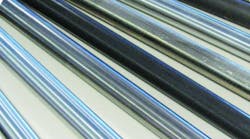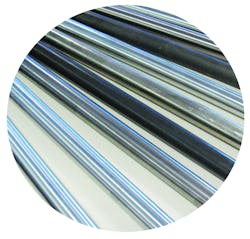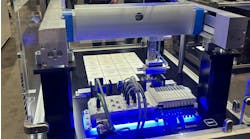This file type includes high resolution graphics and schematics when applicable.
Whether in the aerospace sector or in earth moving equipment, the use of hard-chrome plated piston rods in hydraulic cylinders as protection against corrosion and wear has been a standard practice for a long time. Stricter environmental regulations and demand for increasingly longer service life have led to the development of alternative piston rod coatings in recent years. But how do these new surface treatments affect the performance of the sealing systems? Is there an ideal coating for all applications?
Friction and wear of sealing systems, particularly of rod seals, have a crucial influence on the efficiency and service life of a hydraulic cylinder. As long as the drive power of the hydraulic pump is sufficient, seal friction has a small effect on the efficiency of the hydraulic system. The cylinder’s piston rod seals and wipers prevent fluid leakage from the cylinder and ingress of dirt into the system — even in harsh ambient conditions such as when excavating a riverbed.
In addition to so-called convenience properties, environmental aspects are becoming increasingly important to the operators of modern fluid power systems. The friction properties of piston seals and piston rod seals are particularly important in this context. High static and dynamic friction not only have an adverse effect on seal wear — and, thus, on the efficiency of the entire hydraulic system — but also lead to detrimental stick-slip and high breakaway forces after prolonged rest — sometimes called the Monday-morning effect.
Platings and coatings
The surface roughness of hard-chrome plated piston rods progressively changes during the component’s life cycle. The surface typically becomes smoother over time, which prevents the surface from maintaining a thin film of lubricating oil. The result is higher friction against piston rod seals. Micro-cracks can also form, leading to abrasion of the chrome tips on the piston rod surface and the formation of longer score marks across the entire running surface. These changes have a negative impact on the entire tribological system and can lead to functional failure of the hydraulic equipment.
The demand for piston rod coatings that do not change their roughness and structure even after long service periods has led to the development of new techniques. Parker-Prädifa has extensively tested the effects of these alternative coverings on the performance of piston rod seals. The test results detailed on the next page, plus many other relevant tests, show that the treatment or coating of the piston rod surface has a significant impact on the friction, leakage, and wear behavior of piston rod seals.
In addition to delivering results that could certainly be described as positive, many alternative, initially seal-compatible piston rod coatings were found to exhibit increased seal wear with the resulting premature failure due to leakage after prolonged testing cycles.
On the test rig
Piston rods with the following types of coatings were tested in the Parker-Prädifa physical lab concerning their influence on friction, wear and leakage of piston rods:
• hard-chrome plated piston rods from various
manufacturers with different degrees of roughness,
• hard-chrome plated piston rods with PTFE sur
face treatment,
• ceramic coated piston rods with and without a
sealing coat,
• salt-bath nitrided piston rods,
• plasma-nitrided piston rods (with and without additional grinding process),
• chemically-nickel coated piston rods,
• piston rods with melted compound coatings,
• nitrided and nitro-carburated piston rods, and
• HVOF spray coated piston rods.
HVOF (high velocity oxygen fuel) coatings are produced by first mixing a combustible gas and oxygen within a chamber. The mixture exits the chamber through a nozzle and ignites. A carrier gas then transports a powder feedstock axially into the ignited gas mixture, which distributes the molten particles uniformly onto the piston rod. The combination of kinetic and thermal energy causes the molten particles to impact the rod to produce a coating with characteristics unachievable with the other methods, such as plasma spray coating.
The HVOF process creates extremely dense coatings with bond strengths in excess of 10,000 psi. A clear advantage of HVOF includes the ability to produce very low surface roughness. This frequently results in faster and easier finishing — often eliminating the need for it. HVOF coatings also produce a very predictable and uniform chemistry.
Test methods and results
Dynamic tests on Parker OD, B3, and BS type piston rod seals were performed with piston rods having different coatings in a large number of short- and long-term friction and leakage endurance tests on universal hydraulic rod seal test rigs. The OD is a unidirectional, PTFE buffer seal that vents trapped fluid pressure back into the cylinder. It has a PTFE-filled bronze cap and nitrile-rubber energizer and is considered a low-friction, long-life seal.
Test parameters for DIN 7986 endurance tests
| Operating Pressure | 0 to 200 bar (depend on extent or retract) |
| Oil temperature | 65° C |
| Duration | 500 km (1 million load reversal) |
| Rod diameter | 36 mm |
| Surface speed | 0.15 m/sec |
| Fluid | HLP 46 mineral oil |
The B3 is a nonsymmetrical, polyurethane U-cup with a knife-trimmed, beveled lip. It resists wear, extrusion, and compression set and has no secondary sealing lip. The BS is a nonsymmetrical rod seal made of polyurethane for long life and high extrusion resistance. It has knife-trimmed sealing lip and a secondary lip to enhance sealing and give a tight, stable fit.
In all cases, rod surfaces were analyzed at the beginning and end of the test and changes documented. Test parameters were selected according to in-house and international testing standards, with endurance tests conducted according to DIN 7986.
The graph illustrates the comparison of the friction forces with type B3 U-rings on alternative piston rod coverings. Except with the thermal-spray hard coated (TSHC) piston rod, all U-ring seals tested tended to exhibit the same friction force behavior and friction level on the piston rod seal surfaces with different coverings. The TSHC piston rod used a post spray coating process that produced a homogenous structure with the resulting positive effect on the friction behavior of the test seals. Surface friction remained low, even after the hydraulic system did not operate for long periods time. This positive behavior was considered and implemented in the design of cylinder systems for harbor crane systems, which often come into contact with salt water.
Graph shows friction measured on B3 U-rings mated piston rods seal with various coatings. Values are based on pressure at 20 MPa at a temperature of 60° C.
All coatings exhibit about the same roughness values, with the ratio between peaks and valleys on the surfaces varying significantly. In endurance tests these differences had a major impact on the leakage behaviour of the U-rings. After just very short running periods, a significant increase of leakage due to heavy wear of the U-rings was noted on the piston rods with ceramic coatings. As a result, several of the trials had to be stopped prematurely. In the case of the nitrided and nitrocarburized piston rods, significant wear of the test seals was noted as well. Leakage, however, occurred only on the nitrided rod.
The PTFE type OD sealing edge rings presented a similar picture, but the differences between the various tribological systems were more pronounced in this case.
An ideal plating or coating?
The results of the tests reveal that there is no ideal plating or coating for all application scenarios. Both the standard hard-chrome plating and the alternative techniques exhibit advantages and disadvantages with respect to their impact on the operating performance of piston rod seals.
Therefore, to design the optimal sealing system for a specific application, the total tribological system — the piston seal surface, the lubricant, and the seal — must be subjected to a detailed analysis prior to its use in the field.
Thomas Papatheodorou is manager of technical services at Parker Hannifin’s Seal Group - Europe, Bietigheim-Bissingen, Germany. For more information, visit bit.ly/OH52MC.
This file type includes high resolution graphics and schematics when applicable.





